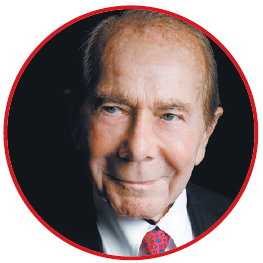
May 4, 1925, in New York
EDUCATION
BA, pre-law certificate, University of Miami
Law degree, New York Law School
CAREER
1952-60: Continental Casualty Company
1960: Vice-president, C.V. Starr & Co
1967: Chairman and CEO, AIG
1988-95: Director, Federal Reserve Bank of New York
1990: Chairman, International Business Leaders' Advisory Council for the mayor of Shanghai
1994: Senior Economic Advisor, Beijing Municipal Government
1994-95: Chairman, Federal Reserve Bank of New York
2005-present: Chairman and CEO, Starr Companies
After a century, looking at a Starr in the making
Giving back
Since 1975, Greenberg has visited many parts of China and tries to go to a different city on every trip. He has been awarded honorary citizenship in five cities - Shanghai, Beijing, Guangzhou, Chongqing and Wuhan.
He has become a strong advocate for closer US-China relations, noting in an earlier interview that "it is in the national interest of both countries to continue building trust and growing mutual understanding."
Since the charitable Starr Foundation was established in 1955, it has made grants to various nonprofit causes worldwide, including several hundred million dollars to causes in China.
Greenberg, the foundation's chairman, said he believes in what it has done to help bridge the differences between the two cultures. "We've done a lot for children's needs, for medical research," he said. "We have built hospitals for children. We are proud of that. In some areas, we are helping feed children in schools."
In 1993, the foundation aided the recovery of missing Chinese relics - bronze window and door panels from a pavilion in the Summer Palace.
During the Boxer Rebellion, around 1900, half of the 20 original bronze window and door panels at the Baoyun Pavilion were removed. The stolen panels ended up at an auction house in Shanghai in 1910 and were purchased by a French bank executive.
Greenberg learned in 1992 that an antique dealer in Paris had the panels. "I called the Chinese embassy first to get in touch with the Chinese museum in Beijing to make sure they are authentic. They did," he said.
Experts authenticated the panels by comparing them with the other 10 panels at Beijing's Palace Museum.
To return them to their rightful place, Greenberg agreed to buy the panels, and paid for their shipment to China's State Bureau of Cultural Relics in July 1993. At a ceremony in December 1993 to celebrate the return of the bronze window and door panels, Zhang Deqin, then-director of the bureau, said sending them back "has opened a new window to link peoples' feelings together".
"We can see through this window a brandnew field of friendly cooperation among people of different races, in different countries and under different social systems," Zhang said.
Greenberg was one of the first people to go into the pavilion when it first opened. He recalled the ceremony was "very emotional".
"The Chinese are very grateful," he said. "It's the first time that somebody gave something back to the Chinese that was taken away. So I'm proud to do that."


